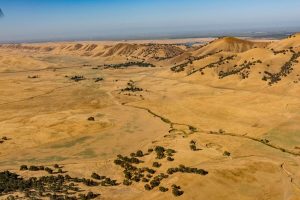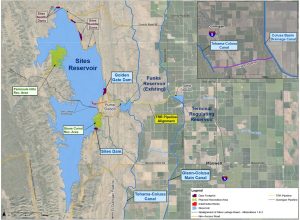By David Guy
As we are staring at one of the most erratic water years in memory, with alternating wet and dry months, we would be well served this year in California if we had water in Sites Reservoir—an off-stream reservoir on the west-side of the Sacramento Valley.
To hear an update on the project, we encourage you to listen to a recent podcast on how Sites Reservoir would benefit California in a dry year like 2022. The Ingrained podcast is available here. If Sites had already been built, nearly 1 million acre feet of additional water would have been available to support the environment, farms and cities in 2021.

As Sacramento River Basin water resources managers look to serve multiple benefits in the future, including fish and wildlife, farms, cities and rural communities, the importance and need for Sites Reservoir becomes clear. Sites Reservoir is an innovative 21st century water project: an off-stream regulating reservoir that can store water for the future by capturing it during high runoff periods, and then releasing water for various beneficial uses at a later time. With its location upstream of the Delta and near the Sacramento River, water in Sites Reservoir would serve multiple benefits in the Sacramento River Basin, as well as the Delta and the rest of the state. Recent dry years have shown the value that similar off-stream reservoirs, such as Diamond Valley and Los Vaqueros, provide California communities and regional water management.

Sites Reservoir would be a dramatic enhancement to California’s water system and the first storage project in California with a dedicated supply for the environment. This facility would provide multiple benefits to improve aquatic habitat conditions and withstand dry year conditions. The reservoir would be operated to accommodate and address the uncertainties created by a changing climate and improve environmental and water supply system resilience. Sites Reservoir can provide a freshwater ecosystem water budget that would help provide flexibility and make water available during drier years–which would help ensure water availability for the ecosystem. Most importantly, Sites Reservoir would significantly improve the state’s water management system in drier periods and restore much needed flexibility and reliability that have been lost in the system.
Recent climate studies have shown that California’s winter runoff is likely to remain similar in volume but come in fewer months of the year, concentrating runoff and increasing flood risks. Adapting to this challenge requires infrastructure that can store surplus water when it is available and deploy it for the ecosystem and human uses when water is not available. Sites Reservoir is one of the best opportunities to re-imagine our water system in the 21st century, prepare for future climate variability, and add value to our current water system by providing high-quality water to enhance the environment, natural infrastructure, public safety, the economy, and quality of life for Californians.
The comment period for the Revised Draft Environmental Impact Report/Supplemental Draft Environmental Impact Statement recently closed and will provide some valuable feedback. Importantly, as we look to the future, it is not only important to address potential impacts to make the project more effective for the region, but we are hoping we can move beyond the potential impacts and look at Sites Reservoir through a lens where the significant environmental benefits are fully seen and acknowledged. Through this lens, Sites Reservoir offers a new and modern approach for the environment by developing a water asset that can be used in a flexible manner for the benefit of fish and wildlife in the Sacramento Valley and the Delta. For this reason, there is strong support from every part of the Sacramento River Basin.
For more information, see Sites Project Authority.




How many mega watts will each pump station pull off grid?? How many mega watts when releasing water?? What prices per Megawatt-hour??